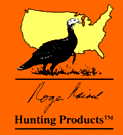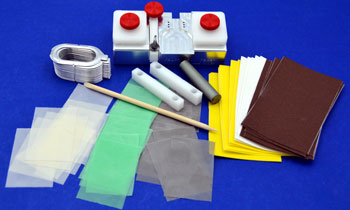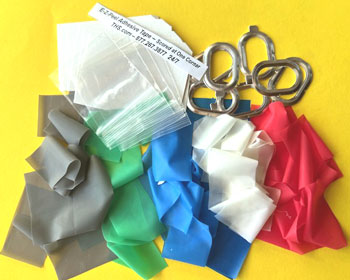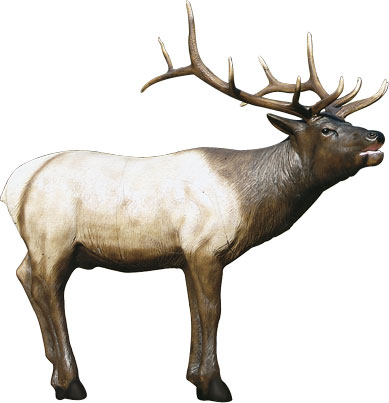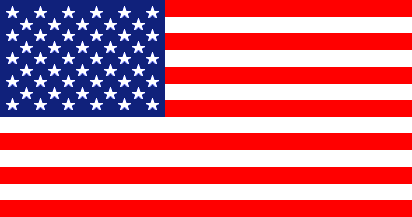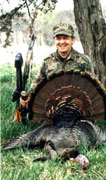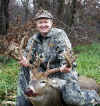To help you the most
with the following descriptions of turkeys, you should obtain a copy of the
Turkey Hunting Secrets
DVD or Turkey Hunting Secrets Book, both of
which provide excellent photography of all ages and sexes of turkeys and provides
additional information on age and sex identification and characteristics of turkeys.
Make sure you know what you're looking for and at.
|

Turkey Hunting Secrets
DVD
Super Sale
Price: $3.99
ORDER
|
 Real Turkeys Audio
CD / Cassettes - by
Dr. Lovett E.
Williams, Jr. Real Turkeys Audio
CD / Cassettes - by
Dr. Lovett E.
Williams, Jr.
The
Serious Turkey Hunter's Audio Guides for Learning and Duplicating
the Voices and
Vocabulary of Wild Turkeys. |
Physical
Characteristics
|
Wild turkeys are
streamlined versions of their domestic barnyard cousins.
They have a longer neck and legs, longer tail feathers and much more slender body.
Their basic body colors appear to be an unimpressive black or dark brown at first
glance.
|
Closer inspection
reveals a myriad of subtle blue, red, bronze, purple and green colors intermingled,
particularly on males. Males appear darker and glossier
than hens, which are a dark, buffy brown color. Their
difference occurs because the tips of a gobbler's body and wing feathers are black, while
those of the hen are brown (white in Merriam's hens).
|
In general, turkeys from
the North are dominated by duller bronze and black colors. Those from the South have
more of an iridescent reddish or greenish-gold tint.
|
Size
|
Wild turkeys are
North America's largest and most spectacular upland game birds.
Fully grown hens weigh 8 to 12 pounds during the fall and winter over most of their
range. Mature toms can occasionally tip the scales at 30 pounds, but there is
considerable variation geographically, and with age.
|
In the South, a 20-pound
gobbler is rare, while in northern ranges average spring weights run 21 to 22
pounds. In general, turkeys are heavier from south to north and west to east.
Even in the Midwest, however, where winter foods in agricultural fields are plentiful, a
25-pound tom is an exceptional specimen. Yearling males, or "jakes" on
northern ranges will weight 12 to 19 pounds in the spring.
|
Weights generally
increase as turkeys get older, but there is so much
variability that it is not an accurate way to determine the age of a gobbler after it
passes its second spring. I have seen very old toms that weighed just over 15 pounds
in the spring, and very fat two-year-old gobblers that weighed 25 pounds.
|
Males are skeletally
larger than hens, but their weight is also supplemented by a "breast sponge", a
globular, fatty tissue weighing several pounds that forms in the hollow "V" in
front of their breast. Toms feed heavily in the late winter and early spring to
build up their sponge, which is used as an energy reserve during the long mating
season.
|
Except where
extended severe winters deplete their condition, both sexes are heaviest just before the
mating season. They lose weight during the spring and
summer and are lightest as fall approaches. Northern adult toms that weighed over 20
pounds in the spring may weigh just 17 to 19 pounds in the fall.
|
Feathers
|
Turkeys have
feathers adapted for other purposes besides flying. The
characteristic strutting display of adult males is spectacular enough to excite the most
experienced hunter. With his wings dropped to the side, tail erect and fanned, and
his head and neck doubled backward in an S-shape over his back, the gobbler appears much
larger than he really is. He uses this display to chase off rivals and to impress
hens with his potential sexual prowess.
|
Hens occasionally go
into an aggressive posture resembling a strut, but it happens so infrequently that most
hunters never witness it. I have seen only one hen go
into the typical gobbler-type strut, with wings dragging the ground, an erect fanned tail,
with her head pulled back against her body in an "S" shape during my nearly 30
years of hunting turkeys. How'd I know it was a
hen? It looked like a hen, plus I bagged the bird with bow and arrow during the fall
and absolutely identified it as a hen then.
|
Beards
|
The feathers with
the greatest appeal to hunters are the modified bristle-like feathers that make up the
beard of an adult gobbler. The beard is a brush-like
appendage that emerges from the breast feathers at the base of the neck. It is the
primary source of bragging rights for successful hunters. Beards are secondary sex
characteristics that appear mostly on males, but also on a small percentage of
hens...maybe 15% of hens have beards.
|
Hens with beards
should not be shot in the spring season because they are fully capable of laying eggs and
raising a brood of young poults. Each beard consists of
up to 600 individual bristles, and grows throughout life. Constant wear and tear
keep the bristles broken off and limits the length of most beards to about 12
inches. Occasionally beards as long as 14 inches have been recorded.
|
Multiple beards are
occasionally found on both males and females. In such cases one beard is usually
dominant, with one to several other smaller ones attached just above or below it.
Hen beards may be long, but they are usually very thin and wispier than those of gobblers.
|
Beards first become
visible on males in their first fall, but may not extend beyond the breast feathers until
late in the year. By spring, young toms generally have 2-to-6 inch beards that stick
out straight like an old-fashioned shaving brush. By their second spring, beards
will average 9 inches in length and continue to grow thereafter.
|
Tracks and Spurs
|
Wild turkeys have
strong legs well adapted for walking and perching. They can easily cover several
miles in a day, but normally restrict their movements to less than a half-mile, unless
they are disturbed.
|
Turkeys fly when
frightened at close range and when going to roost; otherwise they prefer to walk or
run. Their toes are widespread and long, and somewhat larger in males.
Well-defined tracks with a mid-toe longer than 4 1/2 inches or a tip-to-tip distance
between the outer two toes greater than 5 inches probably belongs to an adult male.
Mid-toes and track widths of hens are generally shorter than 4 inches. Young toms
(jakes) are intermediate and difficult to positively distinguish from hens or old toms.
|
A turkey's lower legs are
covered with horn-like scales. These scales tend to be brown or grayish-brown in
young birds, but turn pink with age. There is a great deal of variability in this
characteristic, however, and it should not be used as the primary method to age turkeys.
|
An elongated spur
used for fighting is located on the back side of the legs of males, just above the foot. Spurs appear as small bumps on the legs of young birds of both
sexes, but grow with age only on males. Occasionally males will not have any spurs
whatsoever. Spurs on hens are rare.
|
Jakes will have spurs
ranging from just a bump to 1/2 inch long in the spring. By the time gobblers mature
at two years old, most will have 3/4-to 1-inch spurs that are pointed, or coming to a
point. Beyond the second year, spur growth is so variable that using spur length to
age older toms is not very reliable. Spurs on toms seldom exceed 1 1/2 inches, but
rare trophies have sported 2 inch spurs.
|
Head Adornments
|
The heads of all wild
turkeys are relatively barren of feathers. Males have virtually no head
feathering. Many hens have a strip of feathers up the back of their neck and over
the crown of their head.
|
Male turkeys have
specialized head adornments that are used to communicate their emotional state to other
turkeys. The dewlap is the fleshy lobe of skin hanging
from the throat. This dewlap is also called a wattle by many hunters, and the
wattles also refer to the fleshy lobes of skin at the base of the throat. The
caruncles are the wart-like projections of the neck and forehead. The snood is the
finger-like projection hanging over the bill.
|
During most of the
year, a gobbler's head is a sedate bluish-white, with a dark red wattle. When aroused during a fight or in the breeding season, he can change his
wattle to a bright cherry red, with bright blue around the eyes and a stark white skull
cap. He does this by regulating the blood flow to these
areas, either draining or engorging them with blood. The snood, normally just a
couple of inches long, turns white and can lengthen several inches while the gobbler is
strutting.
|
Hens have blue-gray
heads with a poorly developed wattle. A few will have a
pinkish-reddish cast to the wattle, especially when they are excited, but it will be
distinctly less noticeable than that of a male.
|
Yearling males in their
first spring will have heads mostly resembling adult gobblers, often with a lot of red
color. The heads of jakes in the spring will often lack the obvious blue and white
colors of adult gobblers.
|
A hunter who thinks that
he is about to shoot an old long-bearded trophy that has a head that is only red, had
better be cautious unless the long beard of an adult gobbler is visible.
|
Field
Identification
|
Many of the age and sex
characteristics discussed above are useful for scouting or identifying a bird you have
just shot. Under actual hunting conditions, they are not as useful, especially when trying
to identify turkeys in dull, early morning light.
|
A gobbling or strutting
tom is easy to identify, but suspicious gobblers often sneak in quietly, giving no clue to
their presence until they suddenly appear in front of you. You can't ignore the
possibility that the old gobbler strutting toward you might just be an older jake, out to
steal a hen.
|
Most states include
bearded hens as legal game during the spring, so if you see a beard, you can't go
wrong. But, don't shoot a bearded hen in the spring if you're able to identify her. If you do, you just took a dozens of
future turkeys out of the area. Make sure you
positively identify the beard before deciding to shoot.
|
Turkeys seem to present a
good deal of variability. One or more of the physical characteristics you may need
to age or sex your turkey may not appear as clear cut as described here. It pays to
examine several characteristics to correctly identify your bird.
|
